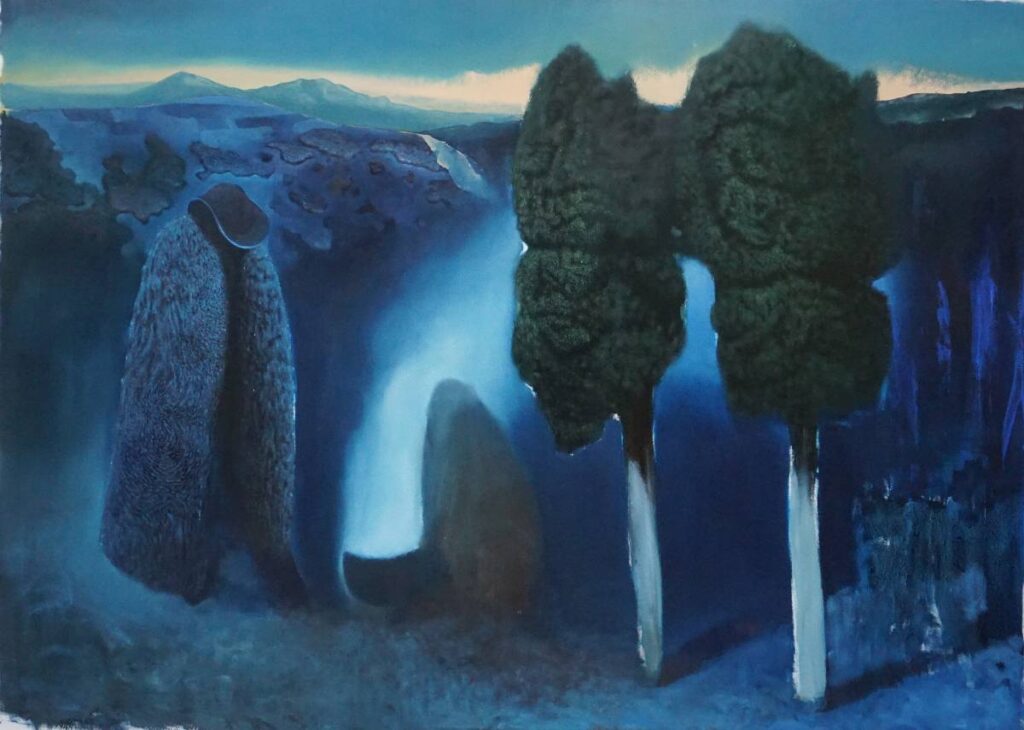The Great Journey
07 March – 06 April 2018
Artist: Radu Băieș
Location: Sector 1 Gallery
The quietly contemplative, even intimate scenes that Radu Băieș depicts for us in his paintings belie an intensity of emotion that emanates from each individual work. Ranging in subject matter from pastoral paintings of sheep with their shepherds, to mystic scenes redolent with symbolism but veiled in deliberate ambiguity and the most emotive Biblical stories, such as The Deposition, Băieș presents a world that is consistently believable but somehow parallel to our own. Narrative is strongly present but never explicit. At times we try and deconstruct and decode the strange, cloaked figures which hover somewhere between shepherds swathed in the skins of their sheep and animated bushes, or wonder at the reasoning behind a couch in a field, but like a dream – and there is a strongly surrealistic element that undergirds Băieș work – the logic only makes sense when confined to this context; for this is an interior world and more about a journey through the mind – both conscious and subconscious – than a reflection of actual reality.
The clue to this comes from the title which the artist has given the exhibition of this body of works. It alludes to the human progression from cradle to grave, i.e., life, but it is also suggestive of the journey of the soul, after life. Indeed the cool palette of Băieș paintings and the soft haze that envelops his subjects (which often seem to be lit from within), point to a theatre of existence that is otherworldly. The blue in Băieș paintings reigns dominant. It sets the mood and gives a particular slant to the reading of his works. The dream-like quality of his paintings pay homage to the influence of Paul Gauguin, whose work: Where do we come from? What are we? Where are we going?, has been a source of inspiration to Băieș, not merely in terms of the use of colour or technique, but the message behinds it. As Băieș comments: I think there is a time when everyone asks, or should ask himself these questions. Like Gauguin who became quietly engaged in observing the community he arrived in, Băieș depicts the people and activities around him that constitute everyday rural life in Transylvania. His protagonists are usually so intently involved in their various activities – be it working in the fields or tending their sheep – that their faces are hidden from our view. Indeed Băieș figures are rarely identifiable from their faces, it is their poses and body language which suggest or reinforce their purpose. This deliberate focus on gesture, form and a kind of fluidity that links all elements of each painting together, serve to make the idea of the journey paramount, rather than secondary to the subject. Băieș has long been interested in the solitary tradition of the shepherd who leads the sheep from the mountain to the valley, and back again, according to the season. Over the centuries – even millennia – many different myths and legends have arisen in connection with the iconic, lone figure of the shepherd tending his flock. Băieș is no stranger to the Christian iconography and pictorial imagery connected with this – Christ talks of His people as a shepherd would his flock and He himself was described as the Holy lamb of God. Throughout the Bible there is a consistent reference to nurture and sacrifice in connection to sheep and their shepherd – such was the importance of their role in everyday life. In Romania where Băieș lives, it is still possible to see this tradition enacted – one of the last remaining places in Europe where ancient routes have lain undisturbed, though they are now also under threat. For Băieș, the journey of the shepherd, undertaken alone, is not about a transformative act, though, or fulfilling a cosmic destiny, it is about re-establishing the spiritual bond between man and nature. This feeling of spirituality is riven through certain works of Băieș – most evidently in the paintings where the narrative is less pronounced and the focus instead is on the viewer becoming one with the spatial plane of the picture. This occurs by the viewer trying to find themselves within the painting itself. For this to happen they need to find the poetry within each work and be prepared to undergo a journey themselves. Perhaps this begins with the same question that Gauguin asked: Where do we come from? What are we? Where are we going? And by letting Băieșs delicately beautiful, meditative works open a doorway into an interior world.
Looking for more?
Address
Băiculești 29 Street, District 1, 013193, Bucharest, Romania
Opening Hours
Tuesday – Saturday, 2 – 7 PM
Sunday – Monday, by appointment only
Newsletter
Sign up to receive the latest news on the gallery’s artists
Sector 1 Gallery © 2023. All Rights Reserved.
Privacy Policy

